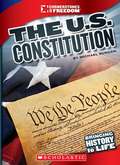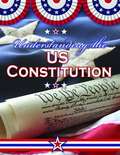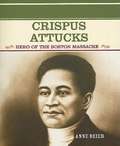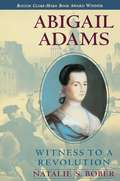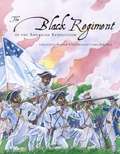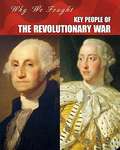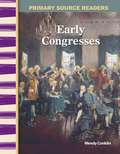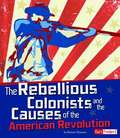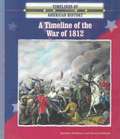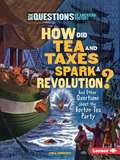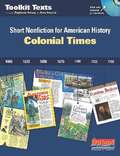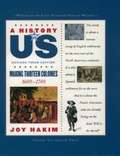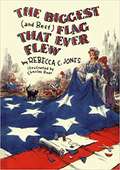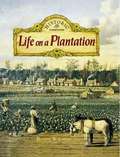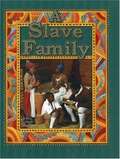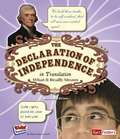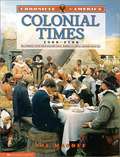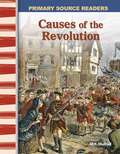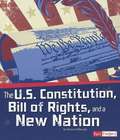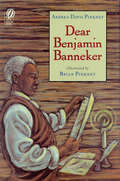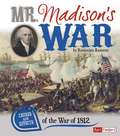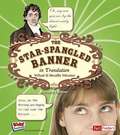Special Collections
District List: BCPS Social Studies - Grade 5
Description: Baltimore City Public Schools Social Studies book list for students in 5th Grade. #bcps
- Table View
- List View
The U.S. Constitution
by Michael Burgan and Gordon Purcell and Terry BeattyLearn about the history of the U.S. Constitution, its primary functions, how it has changed over the years, and why it is still important today.
Even before the first glorious ring of the Liberty Bell, America was a land of freedom and promise. The Cornerstones of Freedom series explores what inspires people from all over the world to start life anew here, endure the economic and social upheavals, and defend the land and rights that are unique to the United States of America.
Understanding The US Constitution
by Sally Isaacs and Baron BedeksyThe United States Constitution is arguably the most important document in America. Full color photos and thrilling text makes learning about the different branches of government and the document that forged them fun for young readers.
Crispus Attucks
by Anne BeierThis book introduces the life of Crispus Attucks, a former slave who died in the Boston Massacre, a fight between the British and American colonists that occurred before the American Revolution.
Abigail Adams
by Natalie S. BoberAbigail Adams was an extraordinary woman who witnessed the gathering storm of the American Revolution and saw the battle of Bunker Hill from a hilltop near her home. Through her letters to friends and family, Abigail Adams lives in history--and now in this award-winning biography by Natalie Bober. Black & white illustrations .
The Black Regiment Of The American Revolution
by Linda Brennan and Cheryl NollThe heroism of America's first Black Regiment during the Revolutionary War is well documented by author Linda Crotta Brennan. Artist Cheryl Kirk Noll complements Brennan's text with large, colorful, detailed illustrations.
Key People Of The Revolutionary War
by Patrick Catel and Megan CotugnoThis book looks at key people of the Revolutionary War: George Washington, King George III, Benedict Arnold, and more.
Early Congresses
by Wendy ConklinThis nonfiction book invites readers to learn about the very first United States Congress and government. Readers will learn about colonists' frustrations with the British and what caused them to create the First and Second Continental Congress, Committees of Correspondence, and the Declaration of Independence. With plenty of colorful images, easy-to-read text, and engaging sidebars, readers will be fascinated from cover to cover as they are introduced to the three branches of U.S. government--executive, legislative, and judicial. A glossary and table of contents are provided for assistance for better understanding the content.
The Rebellious Colonists and the Causes of the American Revolution
by Christopher ForestThe 13 American Colonies had many reasons to begin the Revolutionary War. From the Boston Tea Party to the Intolerable Acts, they felt it was time for independence. Read more about the conflict between the colonists and Great Britain and the events that led up to the American Revolution.
A Timeline Of The War Of 1812
by Sandra Giddens and Owen GiddensAs a young nation, America faced many challenges, including dealing with trade with its former ruler, Great Britain. This book describes the conflict between Great Britain and the United States between the years 1812 and 1815, known as the War of 1812. The timeline shows the relationships among events and brings to life the chronology of war. The intricacies of governing a country will be shown to students by the turbulent beginnings of the American nation.
How Did Tea And Taxes Spark A Revolution?
by Linda GondoschOn a cold evening in December 1773, a group of men climbed aboard three ships docked in Boston Harbor. Armed with hatchets, the men began breaking into the ships’ valuable cargo―342 crates of tea. They dumped the tea into the black water of the harbor and then marched back home through the city streets. This “Boston Tea Party” was a bold act of protest by American colonists against British rule. It pushed the colonies and Great Britain a step closer to war. But who were these protestors? Why would they risk angering the powerful British government? And how did the British respond? Discover the facts about the Boston Tea Party and the colonists’ struggle for independent rule.
Colonial Times
by Stephanie Harvey and Anne GoudvisThese short nonfiction texts for American history include:
10 comprehension strategy lessons for close reading in content literacy.
Short nonfiction articles on a wide range of topics and at a variety of reading levels.
( 45 articles in Colonial Times and 52 articles in The American Revolution and Constitution )
A bank of historical images, primary source documents and artifacts, plus primary source documents and artifacts bibliographies, web sites, and ideas for online investigations.
A Digital Companion Resource provides all of the texts, primary source documents, and the image bank in a full-color digital format so you can display them for group analysis.
A History of US:
by Joy HakimRecommended by the Common Core State Standards for English Language Arts and Literacy as an exemplary informational text.
All kinds of people are coming to America. If you're European, you come in search of freedom or riches. If you're African, you come in chains. And what about the Indians, what is happening to them? Soon with the influx of so many people, thirteen unique colonies are born, each with its own story. Meet Pocahontas and John Smith in Jamestown. Join William Penn and the Quakers in Pennsylvania. Sit with the judges at the Salem witch trials. Hike over the mountains with Daniel Boone. And let Ben Franklin give you some salty advice in his Poor Richard's Almanac in this remarkable journey through the dynamic creation of what one day becomes the United States.
The Biggest (and Best) Flag That Ever Flew
by Rebecca JonesYoung Caroline Pickersgill lives with her mother and grandmother in Baltimore, Maryland. Mrs. Pickersgill, a widow, supports herself and her daughter by making flags for the ships that sail into the city. Some soldiers from Fort McHenry come to her to order the biggest and best flag in the world, and Caroline helps make it. When the British sail up the Chesapeake Bay to destroy Baltimore during the War of 1812, the defenders at the fort beat them back. After the British sail away the next day, the flag gallantly streaming over the fort is the one Caroline and her mother had sewn. “By the dawn’s early light,” Francis Scott Key saw it waving “o’er the land of the free and the home of the brave.” Here is a charming (and true) children’s story about a little person who, in helping her widowed mother, became a part of our nation’s history. Early reader–ages 5-8.
Lexile Measure: 710
Life On A Plantation
by Bobbie KalmanBobbie Kalman's acclaimed Historic Communities Series provides a close-up view of how people lived more than two hundred years ago. Colorful photos, many taken by Bobbie Kalman herself at restored historic villages across the country, help support the fascinating information. Children will have fun learning about: -- early homes and the settler community -- what people wore and the crafts they made -- how settlers made their living -- how they spent their leisure time -- the values, customs, and traditions of the early settlers The era of the southern plantation was a time when many wealthy planters lived in grand style next door to their slaves who helped them achieve it. Life on a Plantation introduces children to the daily routine of a Plantation detailing: -- life in the Big House and in the slave quarters -- work in the cotton, rice, and tobacco fields -- customs and traditions of both black and white communities -- how the slaves helped support each other and pass along African American traditions
Lexile Measure: 920L
A Slave Family
by Bobbie KalmanThe many struggles slaves faced during the colonial period are explained in this look into the personal relationships and daily activities that were part of the slaves' family life. Using full-color photos and illustrations and engaging text, this title celebrates the slaves' family ties while introducing readers to the system of slavery, roles of family members, and much more.
The Declaration Of Independence In Translation
by Amie LeavittWhat are unalienable rights? Who are the 13 original colonies? What makes the Declaration of Independence so important? Find out in simple language what this historical document rally means to you and America.
Chronicle of America
by Joy MasoffThe text re-creates early American settlements by describing in words and pictures various aspects of the colonists' lives; including work, food, clothing, shelter, religion, and relationships with Native Americans.
Causes of the Revolution
by Jill MulhallDiscover what caused the American Revolution in this stimulating nonfiction book. With its easy-to-read text and vivid images, readers are sure to be engaged as they learn about problems colonists faced, including the Stamp Act, the Townshend Act, and Intolerable Acts. The fascinating facts and intriguing sidebars further explore the reasoning behind such documents as the First Continental Congress, Declaration of Rights and Grievances, Thomas Paine's Common Sense, and the Declaration of Independence. To aid in better understanding of the content and vocabulary, a useful table of contents and glossary are provided.
Nystrom Atlas of Our Country's History
by NystromThis atlas tells the story of United States' history through maps, graphs, pictures, and words.
The U. S. Constitution, Bill of Rights, and a New Nation
by Steven Anthony OtfinoskiOn October 19, 1781, British forces laid down their arms in Yorktown, Virginia. Despite the British surrender, the American struggle to form a new nation was far from finished. War debt, rebellions, slavery, and a weak central government warned of dire times ahead. Read more about what happened when the fighting ended and the real work began.
Dear Benjamin Banneker
by Andrea Davis Pinkney and Brian PinkneyThroughout his life Banneker was troubled that all blacks were not free. And so, in 1791, he wrote to Secretary of State Thomas Jefferson, who had signed the Declaration of Independence. Banneker attacked the institution of slavery and dared to call Jefferson a hypocrite for owning slaves. Jefferson responded. This is the story of Benjamin Banneker--his science, his politics, his morals, and his extraordinary correspondence with Thomas Jefferson. Illustrated in full-page scratchboard and oil paintings by Caldecott Honor artist Brian Pinkney.
Mr. Madison's War
by Kassandra RadomskiThe United States won its independence from Great Britain in 1783, but that didn't mean the conflicts were over. By 1812, tensions between the two countries had reached the boiling point. Why would the United States again want to wage war on a rich and powerful country? And how would it change the young nation?
The Star-Spangled Banner in Translation
by Elizabeth RaumHow long is four score and seven years? Just what are unalienable rights? These translations make important historical documents meaningful. Each book translates the work of a primary source into a language you can understand.

